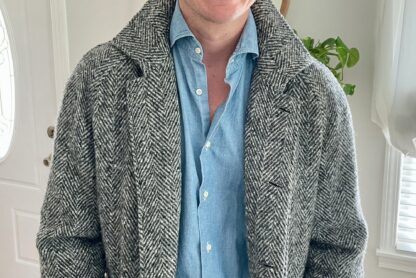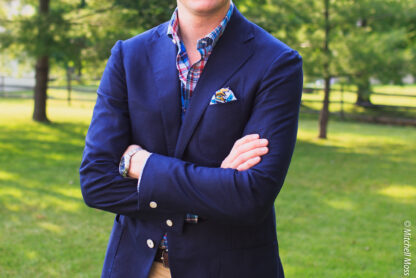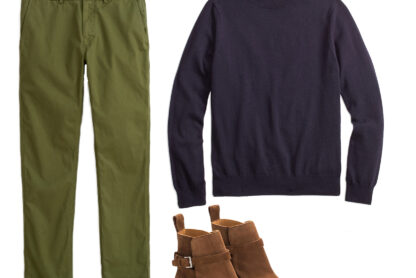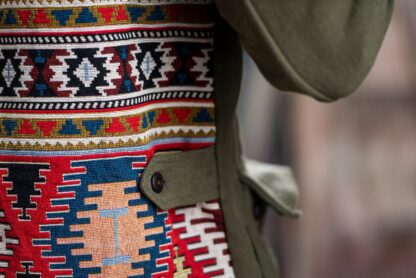(Links below may be affiliate links that earn commission when you make a purchase. Thanks!)
Some dads teach their sons how to shave. We’re all familiar with the shaving montage: the awkward teen with too much lather and an unsteady hand; the sage older man with a smirk of bittersweet humor on his face. It’s a familiar trope. But most dads don’t walk their teenage sons into Sephora to explore the world of skincare. They’ll maybe give them some razor bump remedies, sure, but serums and SPFs are probably a step too far.
But they shouldn’t be. Not only is your skin your largest organ, your face is a huge part of your identity. It’s even more important than your outfit, as evidenced by the existence of social slurs like RBF and Butterface. And, like your weight and income, the skin on your face can be a trailing indicator of your ability to take care of yourself and others. So embrace the vanity, accept that age is going to happen anyway, and implement the following steps in your personal hygiene routine to mitigate the damage.
As someone who taught himself how to shave, I’ll be the first to admit there is an overwhelming number of products and tutorials on items you “need.” Despite there being hundreds of iterations that do slightly different things, I’m going to talk to you like I would coach a client—someone who just wants the best products to address the basics without a 15-step program.
| AM | PM |
| Cleanser | Cleanser |
| Serum | Retinol |
| Eyes | Eyes |
| Moisturizer | Moisturizer |
| SPF |
Step 1: Wash your face
This is usually called the cleanser. You should wash your face in the morning and in the evening. Throughout the day, your facial skin accumulates debris along with sweat and skin oils. If you don’t already wash your face regularly, you might see a lot of your skin issues clear up just from implementing this first step. If you know that you struggle with compliance to a routine, prioritize the evening wash and go to bed with a clean face. (Also, wash your pillowcase at least weekly…) Cleansing does a whole host of important things aside from just making you clean: it washes your pores to mitigate acne, balances skin hydration, slows the aging effects of environmental pollutants and, notable to the rest of this guide, increases the efficacy of the other products you’re about to apply to your face. If your face is covered in a layer of grime, it’s hard for the active ingredients of anything else to reach you.
I prefer the iS Clinical Cleansing Complex because, in addition to being a very good cleanser, it has a good UX. Some cleansers foam or lather like soap. It can be frustrating to chase down all the suds—you keep splashing your face and wind up with a wet shirt. The iS Clinical I linked is more like a thin gel that sticks to water and is therefore easy to wash off. It leaves your face feeling clean and somewhat tightened without being harsh.
Step 2: Target Issues
In the morning, you’ll use a serum. Serums are concentrated formulations that target specific issues (wrinkles, brown spots, free radicals) usually associated with aging and are the only optional thing on this list. SkinCeuticals C E Ferulic is a great choice unless you have more specific needs that you’ll discuss with your dermatologist.

In the evening, instead of a serum you’ll use a retinol. This is an OTC form of Vitamin A, which is the skincare industry’s gold standard for treating or reversing the signs of aging. SkinCeuticals makes several different strengths: 0.3%, 0.5%, & 1.0%. Using these products is like diet and exercise—you’re going to see better results with consistent use. In 10 years, you’ll look younger than your friends. In 20 years you’ll look much younger than your friends. You might also see the term retinoid used interchangeably with retinol in online discussions. Both retinol and retinoid are derivatives of vitamin A, but generally, retinoid is much stronger and always requires a prescription as it is FDA approved to treat some skin conditions.
Step 3: Eyes
The skin around your eyes is some of your most delicate and therefore the first to show wear and tear. Eye creams typically target fine lines, puffiness, discoloration, and bagging. Like with serums, you can research to target your specific needs. The A.G.E. Advanced Eye can be used morning and evening for a compounding effect (plus it’s particularly great to use in the morning because the caffeine will reduce undereye circles). Eye creams can be the most expensive product in the routine because they are often the most complex. But when people look at you, they look at your eyes first—so don’t skimp on the eye cream.
Step 4: Manage Moisture
If you’ve spent any time polishing your shoes, you know that if you clean something, you then have to condition it. The same is particularly true for your face. Cleansing, while excellent for your skin and hygiene, does mean you need to moisturize. Take this opportunity to give your skin an extra chance to absorb vitamins and acids that can help restore elasticity. I prefer the Triple Lipid Restore both because of its efficacy and easy UX.
Step 5: Protect your skin from the sun
The last and possibly most important step is SPF. The sun is your skin’s enemy, and if you only take one thing from this guide, use an SPF every day, all the time, no matter what. There are chemical and mineral SPFs with different regulatory standards for what ingredients are allowed in each. My favorite SPF for the face is SKIN1004 Madagascar Centella because, typically, I hate how SPF smells and feels, and I truly can’t tell I’m wearing the Centella after I rub it in. If you have exposed limbs in your outfit, or a bald head to protect, Supergoop is great for larger coverage areas for the same reasons—it goes on smooth and doesn’t leave you feeling or smelling like the beach. If you have excess SPF on your fingers after you apply it to your face, rub it into the backs of your hands or the back of your neck.
In case you’re wondering about the rationale for the order of application, thinner and lighter items are applied first. If you wear makeup, you always apply it over the SPF.
If you’ve stumbled across this guide and you’re in your teens or early twenties, stick with steps 1, 4, and 5: cleanser, moisturizer, SPF. These should be non negotiable unless you want to look like a leather bag at 30. You could even use a very mild eye cream, but make sure you speak with a dermatologist for age-specific recommendations. My derm has vetted the majority of these products and is particularly a fan of SkinCenticals because of their researched-backed methodology. I, however, am middle aged and came later in life to the importance of skincare.
If you’re more mature, you already know the value of consistency to a fully funded Roth IRA, healthy diet, and consistent exercise. Skin care is now part of your burden of knowledge.
Joshua Davis is the creative director for Monogram Styling, a luxury acquisition and image consulting firm with regular service to Atlanta, New York, Washington, D.C. and by appointment to clients worldwide.
Shop my clothing from this post and every other post on the Shop My Closet page. If you’re just getting into tailored menswear and want a single helpful guide to building a trend-proof wardrobe, buy my eBook. It doesn’t cost that much and covers wardrobe essentials for any guy who wants to look cool, feel cool and make a good impression. Formatted for your phone or computer/iPad so it’s not annoying to read, and it’s full of pretty pictures, not just boring prose. Buy it here.
(If you buy stuff through my links, your clicks and purchases earn me a commission from many of the retailers I feature, and it helps me sustain this site—as well as my menswear habit ;-) Thanks!)














SPF in the PM? As in, before bed? Must be a typo?
Yep, you caught my typo. Thanks!
People are applying SPF at night?
I was in collusion with BIG SPF to increase sales.
The “SPF before bed” part of the chart was a mistake. The chart has been fixed, and the responsible parties have been sacked.